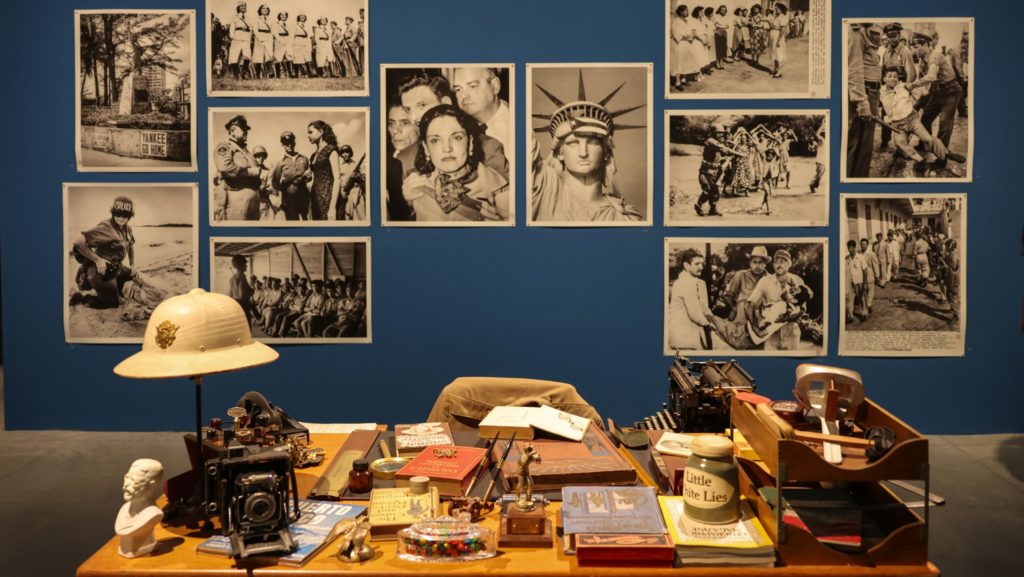Several months ago, I received a text from an Angelus reader who loves Venice and thought I might, too. The Biennale, the once-every-two-years art extravaganza, was in session. She offered to underwrite the entire trip.
So of course I went.
The Biennale’s two main sites are the Giardini (Garden) — a giant garden built by Napoleon at the beginning of the 19th century —and the Arsenale, a huge complex of construction sites dating back to 1104 that symbolize Venice’s economic, political, and military power.
In addition, myriad exhibits were scattered around the city in churches, galleries, and performance spaces.
This year’s theme, originated by Brazilian curator Adriano Pedrosa, is “Foreigners Everywhere.” Divided into four main sections, “Contemporary Nucleus,” “Portraits,” “Abstractions,” and “Italians Everywhere,” the whole affair seemed daunting.
Early my second morning I nonetheless got on the vaporetto — the little boats that transport you around town — disembarked at the Giardini, and plunged in.
The Biennale includes 331 artists, and within the first half-hour I saw that almost every commentary featured such catchphrases as “post-colonial discourse,” “gender normativity,” “intersubjective relation,” “hyper-consumption,” “discriminatory controls,” and “conflict and crisis.”
Ballet, flowers, the human body — all had been pressed into political ends.
As ArtNews noted: “Nothing is here as art qua art — everything is performing for an agenda. No artist is permitted release from the particulars of their identity, for it is here that Pedrosa’s interest lies: in the deracinated, the estranged, the colonised, the marginalised and the excluded.”
To one side of the main pavilion, a life-sized bronze statue of a naked female with a penis labeled “Woman” emblemized the vibe.
Clearly, nonetheless, an incredible amount of thought and energy had gone into selecting and staging the work. And there was plenty to admire.
Outsider Aloïse Corbaz (1886-1964), for example, was an old friend. As a private teacher in the court of Kaiser Wilhelm II, she developed an unrequited romantic obsession with the monarch so severe that she’d been institutionalized at Lausanne and remained there for the rest of her life.
Her large pastels of voluptuous blue-eyed queens and vibrant kings cheered me to no end.
Pablo Delano’s “The Museum of the Old Colony” (2015–ongoing), an archive of photos and objects related to Puerto Rico’s struggle for autonomy, was both horrifying and heartbreaking.
In one photo, an unnamed young woman — so beautiful she could have been a Parisian model — scrubbed laundry; in another, a group of overweight white guys in suits lounged about the base of a palm tree while a naked “native boy” shimmied up the trunk for coconuts. By simply presenting what was, the exhibit made me ashamed of how little I knew of Puerto Rico’s history and struggles.
Moreover, I was keenly aware that thoroughly taking in the Biennale would have required weeks, not hours. (Regrettably, I was unable to secure a reservation to the Holy See pavilion, which was staged at the women’s prison on the island of Giudecca).
Also, it was unbelievably pleasant to walk around the grounds with tons of places to sit, benches, ledges, stairs, in the sun.
At the Arsenale the next day, images of toppling statues, people being hit with sticks by police, and bloodstained sidewalks, walls, and shirts figured prominently. So did grating, grinding industrial noises, and faceless black mannequins: in camo and masks, bound and gagged, in drag.
Then, as at the Giardini, I’d come across something fantastic, like the gorgeous embroidered textile of Las Bordadoras de Isla Negra, a group of self-taught women who, between 1967 and 1980, created colorful works depicting daily life in their Chilean coastal village.
Individual cloths of different scenes were joined together to form a cross-section of Chile ranging from the ocean to the Andes. The embroidery was stolen and disappeared in September 1973, during the Pinochet dictatorship, then mysteriously reappeared in August 2019, and has since been reintegrated into the U.N. building in which it was first installed.
There were galleries of what might be called “cookie-cutter Indigenous,” but then there were the quietly show-stopping batiks of Susanne Wenger (1915-2009), a sculptor, painter, and graphic designer who expatriated to Nigeria and specialized in the Yoruba technique of resist-dyeing whereby a design is first applied with cassava-starch paste, then dipped in indigo dye.
There were darkened rooms I learned not to enter lest I be assaulted with noise, sexual fetish, or incoherent images.
There were videos of people making faces, moving extremely slowly, or undergoing pantomimed attacks.
In one apparently much-admired installation, military men in lacy lingerie climbed a pole through which they were skewered through the anus: this was meant to be a commentary on the “violent indoctrination of identity.”
The overall effect was of a phantasmagoric nightmare realm of flashing neon lights and the soundtrack of a Japanese horror movie.
I thought of a friend I’d talked to the week before. “People are hardly … human anymore,” she’d observed. “I can’t make sense of what’s happening in the world.”
But in the end, I wouldn’t have missed the Biennale for anything. What it said, what it asked, was: Are we not all foreigners, mourning and weeping in this valley of tears? All suffering from unrequited longing, trying the best we can, hoping against hope that we’re capable of giving and receiving love?
Besides, there was a lot more to Venice than the Biennale. To be continued!

